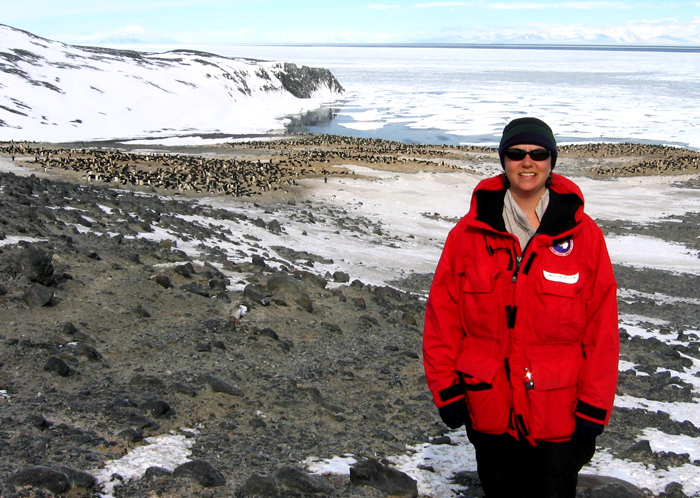|
Keeping countPopulation census key component for understanding dynamics of penguin coloniesPosted March 21, 2008
Katie Dugger, an assistant research professor at Oregon State University, joined the penguin researchers on Ross Island about six years ago to fill the project’s need for a population demographer. Think of her project as the U.S. Census Bureau for Adélie penguins. “It’s going to be a pretty complicated model,” she said in early March after about a five-week stint in Antarctica, mainly working at Ross Island’s Cape Bird, home to a colony of about 40,000 breeding pairs of Adélies. “We’re interested in basically all of the components that go into [the results] of the populations sizes that we see — survival, movement between colonies, reproductive success, survival of young birds versus adults. And breeding propensity, the probability that those who survive and come back [to their birth colony] chose to breed,” added Dugger, who also does demographic work on northern spotted owls in the United States. Dugger said she is beginning work on the most complicated parts of the Adélie population model now. Much of the data come from birds banded by the researchers, allowing them to track the animals’ movements and mortality rates as they age and emigrate between colonies. Dugger has completed calculations on the mortality of banded birds versus non-banded birds, as well as survival differences between colonies. It is still unclear how age will factor into some of the variables that she wants to model. “We are certainly seeing a lot of annual variation in survival,” Dugger said. In fact, the survival rates are so low some years that she believes other factors may be involved in the banded birds’ disappearance. “What we may have going on is more emigration. Birds that are actually leaving our study area … We’re hopefully going to try and figure it out. “We know from other work in long-lived seabirds … what kind of minimum survival rates we would expect to see,” she explained. The Ross Island Adélies, she estimated, can live up to 20 to 25 years. They typically begin breeding by the time they’re 5 or 6 years old, a relatively long period of maturation, which necessitates a long life span if they hope to produce at least one offspring that then survives to breed. In addition to Cape Bird, Dugger and her collaborators study breeding colonies on Cape Royds, Cape Crozier and Beaufort Island. Giant icebergs and receding snowfields on Beaufort Island helped scramble some of the demographics in recent years, as the birds abandoned ice-choked Cape Royds for better real estate at Beaufort Island. Tagging a percentage on the likelihood for the Adélies to migrate is one of Dugger’s chief goals, complicated by the fact that atypical environmental conditions triggered their recent diaspora. “Some of the newish analytical techniques will allow us to predict the probability of a bird moving from one colony to another,” she said. “We certainly saw more movement when the big iceberg was clogging everything up.” Another difficult question to answer: Where do the younger birds flock to prior to the time they first show up on breeding colonies? “That’s a really good question. We’d like to know that,” Dugger said. The scientists assume they share the same wintering habitats as the adults, but the 1- and 2-year-old birds rarely appear at the breeding colonies. (Some birds begin breeding at age 3, or at least appear at breeding colonies.) “They’re hanging out somewhere, maybe just out on the pack ice,” Dugger said. “They just never bother to come ashore. I don’t know. That’s a big mystery right now.” The U.S. scientists will soon have solid population numbers for each colony thanks to work by their New Zealand collaborators, who use aerial photographs to determine population size. “That’s a very key component to all of this,” Dugger said. “We all have feelings about what’s been going on the last five or six years, but until you get down to quantifying it, you can never be sure the way you remember things really translates into actual numbers — not when you’re talking about 45,000 breeding pairs .” NSF-funded research in this story: Katie Dugger, Oregon State University. Return to main story: After the icebergs. |



For USAP Participants |
For The Public |
For Researchers and EducatorsContact UsU.S. National Science FoundationOffice of Polar Programs Geosciences Directorate 2415 Eisenhower Avenue, Suite W7100 Alexandria, VA 22314 Sign up for the NSF Office of Polar Programs newsletter and events. Feedback Form |



